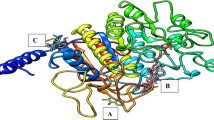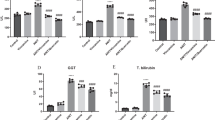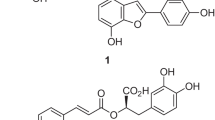Abstract
The current study was conducted to evaluate the ameliorative and protective potentials of Moringea oleifera leaves ethanolic extract (MOLE) against thioacetamide (TAA) toxicity. A total of 58 male albino rats were randomly assigned into six experimental groups. G1, rats received distilled water. G2, rats were injected with a single dose of TAA (200 mg/kg BW) i.p. G3, rats were given MOLE (300 mg/kg BW) orally for 26 days. G4, rats were injected TAA as in G2 and treated with MOLE as G3. G5, rats were kept for 26 days without treatment then on day 27 injected with TAA as in G2. G6, rats were given MOLE for 26 days then on day 27 injected with TAA. Phytochemical analysis of MOLE indicated the presence of kaempferol, kaempferol malonylglucoside, kaempferol hexoside, kaempferol -3-O-glucoside, kaempferol-3-O-acetyl-glucoside, cyanidin -3-O-hexoside, ellagic acid, quercetin, quercetin-3-O-glucoside, and apigenin glucoside. Intoxication of rats with TAA significantly elevated activities of serum AST, ALT, and ALP; concentrations of malondialdehyde, nitric oxide, and hepatic tissue protein expression of caspase 3 and COX2 with alteration of the histological structures of hepatic tissues, while it decreased serum levels of total protein, albumin, and hepatic tissue contents of reduced glutathione. Also, TAA intoxication resulted in 62.5% mortality in rats of G5. Treatment of TAA intoxicated rats (G4) with MOLE ameliorated the toxic effects of TAA on hepatic tissue structure and function. It decreased serum activities of AST, ALT, and ALP; enhanced hepatic GSH concentration; reduced pathological alterations and lipid peroxidation; and downregulated caspase 3 and COX2 proteins expression in hepatic tissue. In addition, MOLE protected rats of G6 from TAA-induced hepatic tissues injury and dysfunction, and increased survival rate of rats. In conclusion, MOLE had both ameliorating and protecting potentials against TAA-induced rats liver damage through regulation of antioxidant, anti-apoptotic, and inflammatory biomarkers.

Graphical abstract








Similar content being viewed by others
References
Abalaka ME, Olonitola OS, Onaolapo JA, Inabo HI (2009) Evaluation of acute toxicity of Momordica charantia extract, using wistar rats to determine safety evels and usefulness of the plant in ethnochemotherapy. Int J Appl Sci 3:1–6
Abd El Latif A, El Bialy BS, Mahboub HD, Abd Eldaim MA (2014) Moringa oleifera leaf extract ameliorates alloxan-induced diabetes in rats by regeneration of β cells and reduction of pyruvate carboxylase expression. Biochem Cell Biol 92:413–419
Abd Eldaim MT, Abd Elrasoul AS, Abd Elaziz SA (2017) An aqueous extract from Moringa oleifera leaves ameliorates hepatotoxicity in alloxan-induced diabetic rats. Biochem Cell Biol 95:524–530
Abdel Salam OM, Mohammed NA, Sleem AA, Farrag AR (2013) The effect of antidepressant drugs on thioacetamide-induced oxidative stress. Euro Rev Med Pharmacol Sci 17:735–744
Ajith TA, Hema U, Awathy MS (2007) Zinziber officinale prevents acetaminophen-induced acute hepatotoxicity by enhancing antioxidant status. Fd Chem Toxicol 45:2267–2272
Akhtar T, Sheikh N (2013) An overview of thioacetamide-induced hepatotoxicity. J Toxin Rev 32:43–46
Alain A, Akpovi CD, Sègbo J, Senou M, Anago E, Ahoyo TA et al (2016) Attenuation effect of Moringa oleifera leaves powder on blood biochemical disturbance induced in lead-exposed rats. Int Res J Biol Sci 5:14–21
Algandaby MM (2016) Antifibrotic effects of crocin on thioacetamide-induced liver fibrosis in mice. Saudi J Biol Sci 10:1–8
Alshawsh MA, Abdulla MA, Ismail, S.& Amin, Z. A. (2011) Hepatoprotective effects of orthosiphon stamineus extract on thioacetamideinduced liver cirrhosis in rats. Evidence-based, complement. Altern Med:1–6
Amjad MS, Qureshi H, Arshad M, Chaudhari SK, Masood M (2015) The incredible queen of green: nutritive value and therapeutic potential of Moringa oleifera lam. J Coast Life Med 3:744–751
Avraham Y, Grigoriadis N, Pautahidis T, Magen I, Vorobiav L, Zolotarev O et al (2009) Capsaicin affects brain function in a model of hepatic encephalopathy associated with fulminant hepatic failure in mice. Br J Pharmacol 158:896–906
Aydin AF, Kusku-Kiraz Z, Dogru-Abbasoglu S, Gulluoglu M, Uysal M, Kocaktoker N (2010) Effect of carnosine against thioacetamide-induced liver cirrhosis in rat. Peptide 31:67–71
Baeuerle PA, Baichwal VR (1997) NF-kappa B as a frequent target for immunosuppressive and anti-inflammatory molecules. Adv Immunol 65:111–137
Baskaran Y, Periyasamy V, Venkatraman AC (2010) Investigation of antioxidant, anti-inflammatory and DNA-protective properties of eugenol in thioacetamide-induced liver injury in rats. Toxicology 268:204–212
Berkovich L, Earon G, Ron I, Rimmon A, Vexler A, Lev-Ari S (2013) Moringa oleifera aqueous leaf extract down-regulates nuclear factor-kappaB and increases cytotoxic effect of chemotherapy in pancreatic cancer cells. BMC Complement Altern Med 13:212
Beutler E, Duron O, Kelly BM (1963) Improved method for the determination of blood glutathione. J Lab Clin Med 61:882–888
Budavari S (1996) The Merck Index—an encyclopedia of chemicals, drugs, and biologicals. Merck and Co., Inc, Whitehouse Station, NJ, p 1590
Buraimoh AA, Bako G, Ibrahim FB (2011) Hepatoprotective effect of ethanolic leave extract of Moringaoleifera on the histology of paracetamol induced liver damage in Wistar rats. Int J Anim Vet Adv 3:10–13
Butterworth RF, Norenberg Md, Felipo V, Ferenci P, Albrecth J, At B (2009) Experimental models of hepatic encephalopathy: ISHEN guidelines. Liver Int 29:783–788
Chen T, Subeq Y, Lee R et al (2008) Single dose intravenous thioacetamide administration as a model of acute liver damage in rats. Int J Exp Pathol 89:223–231
Chen W, Saxena A, Li N, Sun J, Gupta A, Lee DW, Dobaczewski M, Frangogiannis NG (2012) Endogenous IRAK-M attenuates postinfarction remodeling through effects on macrophages and fibroblasts. Arterioscler Thromb Vasc Biol 32:2598–2608
Chilakapati J, Shankar K, Korrapati MC, Hill RA, Mehendale HM (2005) Saturation toxicokinetics of thioacetamide: role in initiation of liver injury. Drug Metab Dispos 33:1877–1885
Chinonyelum AN, Uwadiegwu AP, Nwachukwu O, Emmanuel O (2015) Evaluation of hepatoprotective activity of Colocasia esculenta (L. Schott) leaves on thioacetamide-induced hepatotoxicity in rats. Pak J Pharm Sci 28:2237–2241
Chittenden T, Harrington EA, O'Connor R, Flemington C, Lutz RJ, Evan GI, Guild BC (1995) Induction of apoptosis by the Bcl-2 homologue Bak. Nature 374:733–736
De David C, Rodrigues G, Bona S, Meurer L, González-Gallego J, Tuñón MJ, Marroni NP (2011) Role of quercetin in preventing thioacetamide-induced liver injury in rats. Toxicol Pathol Oct 39:949–957
Dhanalakshmi S, Agarwal P, Glode LM, Agarwa R (2003) Silibinin sensitizes human prostate carcinoma DU145 cells to cisplatin- and carboplatin induced growth inhibition and apoptotic death. Int J Cancer 106:699–705
Doumas BT, Watson WA, Biggs HG (1971) Albumin standards and the measurement of serum albumin with bromocresol green. Clin Chim Acta 31:87–96
Efsen E, Bonacchi A, Pastacaldi S et al (2001) Agonist-specific regulation of monocyte chemoattractant protein-1 expression by cyclooxygenase metabolites in hepatic stellate cells. Hepatology 33:713–721
El-bakry K, Toson EL, Serag M, Aboser M (2016) Hepatoprotective effect of Moringa Oleifera leaves extract against carbon tetrachloride-induced liver damage in rats. World J Pharm Pharm Sci 5:76–89
Eleftheriadis T, Pissas G, Liakopoulos V, Stefanidis (2016) Cytochrome c as a potentially clinical useful marker of mitochondrial and cellular damage. Front Immunol 7:279
Emi M, Kim R, Tanabe K, Uchida Y, Toge T (2005) Targeted therapy against Bcl-2-related proteins in breast cancer cells. Breast Cancer Res 7:940–952
Ezuruike UF, Prieto JM (2015) The use of plants in the traditional management of diabetes in Nigeria: pharmacological and toxicological considerations. J Ethnopharmacol, x 155:857–924
Fawcett JK, Scott JE (1960) A rapid and precise method for the determination of urea. J Chim Pathol 13:156–159
Fazal Y, Fatima SN, Shahid SM, Mahboob T (2015) Effects of curcumin on angiotensin converting enzyme gene expression, oxidative stress and anti-oxidant status in thioacetamide-induced hepatotoxicity. J ReninAngiotensin-Aldosterone Syst 16:1046–1051
Feldstein AO, Canbay A, Angulo P, Taniai M, Burgart LJ et al (2003) Hepatocyte apoptosis and Fas expression are prominent features of human nonalcoholic steatohepatitis J. GORES, Gastroenterology 125:437–443
Ghosh S, Sarkar A, Bhattacharyya S, Sil PC (2016) Silymarin protects mouse liver and kidney from thioacetamide induced toxicity by scavenging reactive oxygen species and activating PI3K-Akt pathway. Front Pharmacol 7:481
Giannitrapani L, Ingrao S, Soresi M, Florena AM, La Spada E, Sandonato L, D'Alessandro N, Cervello M, Montalto G (2009) Cyclooxygenase-2 expression in chronic liver diseases and hepatocellular carcinoma: an immunohistochemical study. Ann N Y Acad Sci 1155:293–299
Giunta S, Castorina A, Marzagalli R, Szychlinska MA, Pichler K, Mobasheri A, Musumeci G (2015) Ameliorative effects of PACAP against cartilage degeneration. Morphological, immunohistochemical and biochemical evidence from in vivo and in vitro models of rat osteoarthritis. Int J Mol Sci 16:5922–5944
Gornall AC, Bardawill CJ, David MM (1949) Determination of serum proteins by means of biuret reaction. J Biol Chem 177:751–766
Hajovsky L, Hu G, Koen Y, Sarma D, Cui W, Moore D et al (2012) Metabolism and toxicity of thioacetamide and thioacetamide S-oxide in rat hepatocytes. Chem Res Toxicol 25:1955–1963
Hayami S, Ikeda K, Sun F, Tanaka K, Kojo S (1999) Increase of caspase-3 activity in rat liver and plasma by thioacetamide. Biochem Pharmacol 58:1941–1943
Henry RJ (1964) Clinical chemistry, Principles and Technics. Harper and Row Publishers, New York
Hu KQ (2003) Cyclooxygenase 2 (COX2)-prostanoid pathway and liver diseases. Prostaglandins Leukot. Essent. Fatty Acids 69:329–337
Huppertz B, Frank HG, Kaufmann P (1999) The apoptosis cascade—morphological and immunohistochemical methods for its visualization. Anat Embryol 200:1–18
Hussein S, Elhadary A, Elgzar Y (2014) Biochemical study on the protective effect of curcumin on thioacetamide induced hepatotoxicity in rats. BVMJ 27:175–185
Iqbal S, Bhanger MI (2006) Effect of season and production location on antioxidant activity of Moringea oleifiera leaves growen in Pakistan. J Food Compos Anayl 19:544–551
Kabiri N et al (2013) The effect of silymarin on liver injury induced by thioacetamide in rats. J HerbMed Pharmacol 2:29–33
Khawar MB, Abbasi MH et al (2016) Punjab Univ. Alterations in proteins and transaminases activity induced by thioacetamide in albino rats. J Zool 31:269–276
Kim KH et al (2000) Role of metabolic activation by cytochorome P450 in thioacetamide-induced suppression of antibody response in male BALB/C mice. Toxicol Lett 114:225–235
Koek GH, Liedorp PR, Bast A (2011) The role of oxidative stress in non-alcoholic steatohepatitis. Clin Chim Acta 412:1297–1305
Lee WM (2012) Acute liver failure. Semin Respir Crit Care Med 33:36–45
Luqman S, Srivastava S, Kumar R, Maurya AK, Chanda D (2012) Experimental assessment of Moringa oleifera leaf and fruit for its antistress, antioxidant, and scavenging potential using in vitro and in vivo assays. Evid Based Complement Alternat Med eCAM 519084:1–12
Mandal PK, Bishayee A, Chatterjee M (1993) Stimulation of tissue repair by Mikania cordata root extract in carbon tetrachloride-induced liver injury in mice. Phytother Res 7:103–105
Mansour HH, Abd El Azeem MG, Ismael NE (2014) Protective effect of Moringa oleifera on γ- radiation-induced hepatotoxicity and nephrotoxicity in rats. Am J Phytomed Clin Ther 2:495–508
Mansour DF, Nada SA, Eldenshary ES, Elmahmoudy BM, AbdElgayed SS (2015) Antioxidant and hypo-ammonemic activities of alpha-lactalbumin and vitamin C in thioacetamide-induced liver and brain damage in rats. J Appl Pharm Sci 5:072–081
Merrill JE, Murphy SP, Mitrovic B, Mackenzie-Graham A, Dopp JC, Ding M, Griscavage J, Ignarro LJ, Lowenstein CJ (1997) Inducible nitric oxide synthase and nitric oxide production by oligodendrocytes. J Neurosci Res 48:372–384
Minnady M, Paulraj-Dominic S, Thomas S, Subramanian S (2010) Therapeutic role of edible mushroom Pleurotus florida on thioacetamide induced hepatotoxicity in rats. Int J Curr Res 5:041–046
Modi DC, Patel JK, Shah BN, Nayak BS (2010) Phytopharmacology of moringa oleifera—an edible plant. Pharmacologyonlin 2:692–705
Montgomery, H. A. C. & Dymock, J. F. (1961). Analyst, 86:414
Muangnoi C, Chingsuwanrote P, Praengamthanachoti P, Svasti S, Tuntipopipat S (2012) Moringa oleifera pod inhibits inflammatory mediator production by lipopolysaccharide-stimulated RAW 264.7 murine macrophage cell lines. Inflammation 35:445–455
Murray RL (1984) Creatinine. Kaplan A. Clin. Chem. The C. V. Mosby co. St. Louis. Toronto. Princeton, 1261-1266 and 418
Musumeci G, Loreto C, Carnazza ML, Martinez G (2011) Characterization of apoptosis in articular cartilage derived from the knee joints of patients with osteoarthritis. Knee Surg Sports Traumatol Arthrosc 19:307–313
Musumeci G, Castrogiovanni P, Loreto C, Castorina S, Pichler K, Weinberg AM (2013) Post-traumatic caspase-3 expression in the adjacent areas of growth plate injury site. A morphological study. Int J Mol Sci 14:15767–15784
Musumeci G, Castrogiovanni P, Mazzone V, Szychlinska MA, Castorina S, Loreto C (2014) Histochemistry as a unique approach for investigating normal and osteoarthritic cartilage. Eur J Histochem 58:107–111
Ohkawa H, Ohishi N, Yagi K (1979) Assay for lipid peroxides in animal tissues by thiobarbituric acid reaction. Anal Biochem 95:351–358
Padma P, Setty OH (1997) Protective effect of Phyllan thus fraternus against thioacetamide-induced mitochondrial dysfunction. J Clin Biochem Nutr 22:113–123
Paik YH, Kim JK, Lee JI, Kang SH, Kim DY, An SH, Lee SJ, Lee DK, Han KH, Chon CY, Lee SI, Lee KS, Brenner DA (2009) Celecoxib induces hepatic stellate cell apoptosis through inhibition of Akt activation and suppresses hepatic fibrosis in rats. Gut 58:1517–1527
Park E, Cheenpracha S, Chang L, Kondratyuk T, Pezzuto J (2011) Inhibition of lipopolysaccharide-induced cyclooxygenase-2 expression and inducible nitric oxide synthase by 4-[(2′-O-acetyl-α-l-rhamnosyloxy) benzyl] isothiocyanate from Moringa oleifera. Nutr Cancer 63:971–982.4
Patel V, Sanyal AJ (2013) Drug-induced steatohepatitis. Clin Liver Dis 17:533–537
Perez-Tortosa V, Lopez-Orenes A, Martinez-Perez A, Ferrer MA, Calderon AA (2012) Antioxidant activity and rosmarinic acid changes in salicylic acid treated Thymus membranaceus shoots. FoodChemistry 130:362–369
Rao SV, Einstein JW, Das K (2014) Hepatoprotective and antioxidant activity of Lannea coromandelica Linn on thioacetamide induced hepatotoxicity in rats. Int Lett Nat Sci 3:30–43
Reed JC (1994) Bcl-2 and the regulation of programmed cell death. J Cell Biol 124:1–6
Reitman S, Frankel S (1957) A colorimetric method for the determination of serum glutamic oxalacetic and glutamic pyruvic transaminases. Amer J Clin Pathol 28:56–63
Rodríguez-Pérez C, Quirantes-Piné R, Fernández-Gutiérrez A, Segura-Carretero A (2015) Optimization of extraction method to obtain a phenolic compounds-rich extract from Moringa oleifera Lam leaves. Ind Crop Prod 66:246–254
Roloff AH, Weisgerber H, Lang U, Stimm B, Schutt P (2009) Enzyklopdie der Holzgewchse. Handbuch und Atlas der Dendrologie 43:1–8
Rosalki SB, Mcintyre N (1999) Biochemical investigations in the management of liver disease. In: Oxford textbook of clinical hepatology, 2nd edn. Oxford university press, New York, pp 503–521
Saad RA, Fath El-Bab M, Shalaby AA (2013) Attenuation of acute and chronic liver injury by melatonin in rats. J Taiba Uni Sci 7:88–96
Seki E et al (2007) TLR4 enhances TGF-beta signaling and hepatic fibrosis. Nat Med 13:1324–1332
Shakibaei M, John T, Seifarth C, Mobasheri A (2007) Resveratrol inhibits IL-1β-induced stimulation of caspase-3 and cleavage of PARP in human articular chondrocytes in vitro. Ann N Y Acad Sci 1095:554–563
Siddhuraju P, Becker K (2003) Antoxidant properties of various solvent extracts of total phenolic of constituents from three different agroclimatic origins of drumstick tree (Moringa oleifera tree lam) leaves. J. Agric Food Chem 51:2144–2155
Singh D, Arya PV, Aggarwal VP, Gupta RS (2014) Evaluation of antioxidant a hepatoprotective activities of Moringa oleifera lam. Leaves in carbon tetrachloride-intoxicated rats. Antioxidants 3:569–591
Sinha M, Das DK, Datta S, Ghosh S, Dey S (2012) Amelioration of ionizing radiation induced lipid peroxidation in mouse liver by Moringa oleifera lam leaf extract. Indian J Exp Biol 50:209–215
Sto Satoh K (1978) Serum lipid peroxide in cerebrovascular disorders determined by a new colorimetric method. Clin Chim Acta 90:37–43
Ujah OF, Ujah IR, Johnson JT, Ekam VS (2013) Effect of leaf extract of Moringa oleifera on carbon tetrachloride (CCl4) induced hepatotoxicity. J Nat Prod Plant Resour 3:15–22
Wang ME, Chen YC, Chen IS, Hsieh SC, Chen SS, Chiu CH (2012) Curcumin protects against thioacetamide-induced hepatic fibrosis by attenuating the inflammatory response and inducing apoptosis of damaged hepatocytes. J Nutr Biochem 23:1352–1366
Wullaert A, van Loo G, Heyninck K, Beyaert R (2007) Hepatic tumor necrosis factor signaling and nuclear factor-kappaB: effects on liver homeostasis and beyond. Endocr Rev 28:365–386
Yang M, Chen J, Zhao J, Meng M (2014) Etanercept attenuates myocar- dial ischemia/reperfusion injury by decreasing inflammation and oxidative stress. PLoS One 9:e108024
Yin M, Lian L, Piao D et al (2007) Tetrandrine stimulates the apoptosis of hepatic stellate cells and ameliorates development of fibrosis in a thioacetamide rat model. World J Gastroenterol 13:1214–1220
Zaleska AP, Gorska JW, Sobezak J, Hupka J (2007) Thioacetamid and thiourea impact on visible light activityof TiO2. Appl Catal B Environ 76:1–8
Zamli Z, Sharif M (2011) Chondrocyte apoptosis: a cause or consequence of osteoarthritis? Int J Rheum Dis 14:159–166
Acknowledgments
The phytochemical analysis in this manuscript was performed by the help of Professor Hesham El-Seedi, Department of Chemistry, Faculty of Science, Menoufia University, Egypt, and Pharmacognosy Group, Department of Medicinal Chemistry, Uppsala University, Sweden.
Author information
Authors and Affiliations
Corresponding author
Additional information
Responsible editor: Philippe Garrigues
Publisher’s note
Springer Nature remains neutral with regard to jurisdictional claims in published maps and institutional affiliations.
Rights and permissions
About this article
Cite this article
Mousa, A.A., El-Gansh, H.A.I., Eldaim, M.A.A. et al. Protective effect of Moringa oleifera leaves ethanolic extract against thioacetamide-induced hepatotoxicity in rats via modulation of cellular antioxidant, apoptotic and inflammatory markers. Environ Sci Pollut Res 26, 32488–32504 (2019). https://doi.org/10.1007/s11356-019-06368-4
Received:
Accepted:
Published:
Issue Date:
DOI: https://doi.org/10.1007/s11356-019-06368-4




